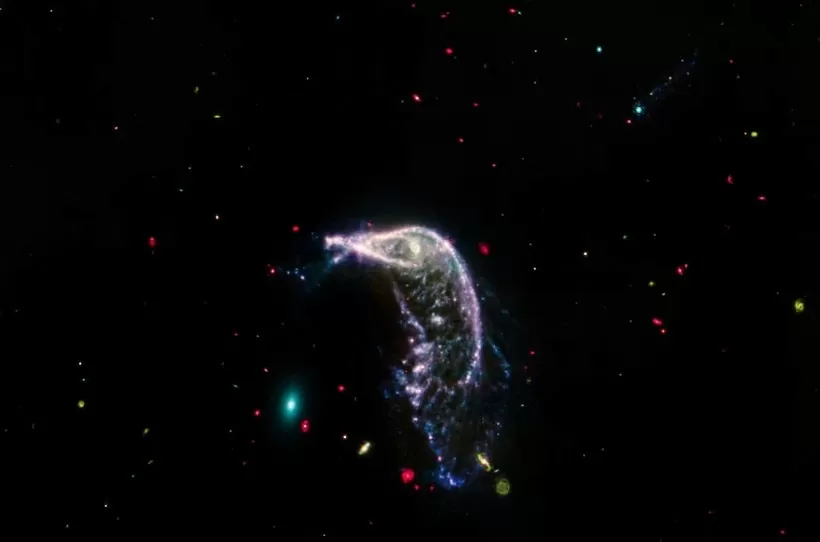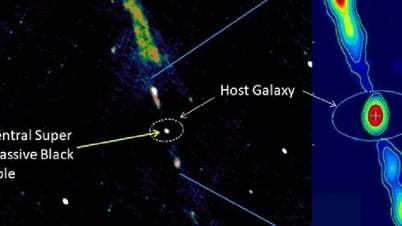On July 12, the US National Aeronautics and Space Administration (NASA) released two photos taken from the James Webb Space Telescope showing two galaxies "Penguin" and "Egg" in the process of merging.
 |
| James Webb Telescope captures galaxies merging. (Source: Reuters) |
The two photos were released to mark the second anniversary of NASA announcing the first scientific results from the space observatory.
The James Webb Space Telescope was launched in 2021 and began collecting data the following year. Webb has reshaped our understanding of the early universe, as well as helping to capture stunning images of the cosmos.
The two galaxies, the "Penguin" and the "Egg," are located 326 million light-years from Earth in the constellation Hydra. When merged together, they are collectively known as Arp 142.
The "Penguin" galaxy, officially named NGC 2936, is a spiral galaxy.
The "Egg" galaxy, also named for its elliptical shape, is officially known as NGC 2937. The image captured by James Webb shows the two galaxies slowly blending in a haze of stars and gas, like a penguin hugging an egg to protect it.
According to NASA, the interaction between these two galaxies began 25 to 75 million years ago and the process of merging into one galaxy will end after hundreds of millions of years.
Since its launch, Webb has observed galaxies filled with stars that formed within a few hundred million years of the Big Bang that marked the beginning of the universe about 13.8 billion years ago.
Webb discovered the earliest known galaxies and provided a better understanding of areas such as the composition of extrasolar planets, known as exoplanets, and the nature of star-forming regions in the universe.
Born after the Hubble telescope, Webb was designed with many superior capabilities. Webb observed the universe mainly in the infrared region, while Hubble has mainly monitored in the optical and ultraviolet wavelength regions.
Source: https://baoquocte.vn/chiem-nguong-canh-thien-ha-chim-canh-cut-va-qua-trung-hop-nhat-278580.html



![[Photo] General Secretary To Lam attends the conference to review 10 years of implementing Directive No. 05 of the Politburo and evaluate the results of implementing Regulation No. 09 of the Central Public Security Party Committee.](https://vphoto.vietnam.vn/thumb/1200x675/vietnam/resource/IMAGE/2025/5/19/2f44458c655a4403acd7929dbbfa5039)
![[Photo] President Luong Cuong presents the 40-year Party membership badge to Chief of the Office of the President Le Khanh Hai](https://vphoto.vietnam.vn/thumb/1200x675/vietnam/resource/IMAGE/2025/5/19/a22bc55dd7bf4a2ab7e3958d32282c15)
![[Photo] Close-up of Tang Long Bridge, Thu Duc City after repairing rutting](https://vphoto.vietnam.vn/thumb/1200x675/vietnam/resource/IMAGE/2025/5/19/086736d9d11f43198f5bd8d78df9bd41)

![[Photo] Panorama of the Opening Ceremony of the 43rd Nhan Dan Newspaper National Table Tennis Championship](https://vphoto.vietnam.vn/thumb/1200x675/vietnam/resource/IMAGE/2025/5/19/5e22950340b941309280448198bcf1d9)



























![[Photo] Prime Minister Pham Minh Chinh inspects the progress of the National Exhibition and Fair Center project](https://vphoto.vietnam.vn/thumb/1200x675/vietnam/resource/IMAGE/2025/5/19/35189ac8807140d897ad2b7d2583fbae)



























































![[VIDEO] - Enhancing the value of Quang Nam OCOP products through trade connections](https://vphoto.vietnam.vn/thumb/402x226/vietnam/resource/IMAGE/2025/5/17/5be5b5fff1f14914986fad159097a677)





Comment (0)